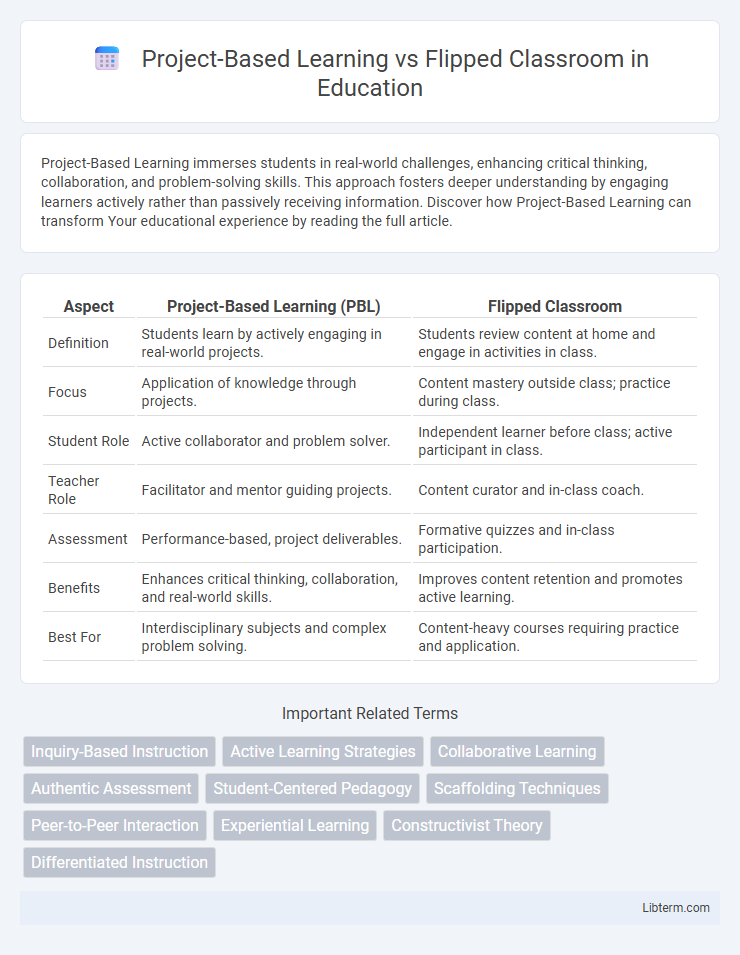Project-Based Learning immerses students in real-world challenges, enhancing critical thinking, collaboration, and problem-solving skills. This approach fosters deeper understanding by engaging learners actively rather than passively receiving information. Discover how Project-Based Learning can transform Your educational experience by reading the full article.
Table of Comparison
| Aspect | Project-Based Learning (PBL) | Flipped Classroom |
|---|---|---|
| Definition | Students learn by actively engaging in real-world projects. | Students review content at home and engage in activities in class. |
| Focus | Application of knowledge through projects. | Content mastery outside class; practice during class. |
| Student Role | Active collaborator and problem solver. | Independent learner before class; active participant in class. |
| Teacher Role | Facilitator and mentor guiding projects. | Content curator and in-class coach. |
| Assessment | Performance-based, project deliverables. | Formative quizzes and in-class participation. |
| Benefits | Enhances critical thinking, collaboration, and real-world skills. | Improves content retention and promotes active learning. |
| Best For | Interdisciplinary subjects and complex problem solving. | Content-heavy courses requiring practice and application. |
Introduction to Project-Based Learning and Flipped Classroom
Project-Based Learning (PBL) immerses students in real-world challenges, promoting critical thinking, collaboration, and applied knowledge through extended projects. The Flipped Classroom inverts traditional teaching by delivering instructional content online outside of class, freeing in-class time for active learning and personalized support. Both approaches enhance student engagement and deepen understanding by prioritizing interactive, student-centered experiences over passive lectures.
Key Principles of Project-Based Learning
Project-Based Learning centers on real-world problem-solving through collaborative projects that promote critical thinking, creativity, and deep understanding of subject matter. Key principles include student-driven inquiry, sustained inquiry over time, and authentic assessment reflecting real-life applications. This approach contrasts with the Flipped Classroom model, where direct instruction happens outside class and class time focuses on interactive activities.
Core Concepts of the Flipped Classroom Model
The Flipped Classroom model centers on reversing traditional teaching by delivering instructional content, often via video lectures, outside of class time, enabling active learning during classroom sessions. Core concepts include pre-class preparation, where students engage with materials independently, and in-class activities that emphasize collaboration, problem-solving, and application of knowledge under teacher guidance. This approach enhances student engagement and allows personalized support, fostering deeper understanding and retention of subject matter.
Comparing Instructional Design Approaches
Project-Based Learning (PBL) centers on student-driven exploration and real-world problem solving, promoting deep engagement through hands-on projects that integrate multiple skills across disciplines. The flipped classroom approach restructures traditional teaching by delivering instructional content outside class, typically via video lectures, freeing in-class time for interactive activities and personalized support. Both methodologies enhance active learning, but PBL emphasizes comprehensive project completion while flipped classrooms prioritize content mastery and application during face-to-face sessions.
Student Engagement: PBL vs Flipped Classroom
Project-Based Learning (PBL) significantly enhances student engagement by fostering hands-on, real-world problem solving that demands collaboration and active participation. The Flipped Classroom model increases engagement by shifting direct instruction outside of class time, allowing in-class sessions to focus on interactive activities, personalized support, and deeper discussion. Studies show PBL leads to higher retention and intrinsic motivation, while Flipped Classrooms improve class participation and allow teachers to address diverse learning styles effectively.
Assessment Methods in Both Models
Project-Based Learning (PBL) assessments emphasize authentic evaluation through real-world projects, requiring students to demonstrate critical thinking, collaboration, and problem-solving skills via presentations, reports, and peer reviews. In Flipped Classroom models, assessment methods often include formative quizzes, in-class activities, and personalized feedback to gauge understanding of pre-class content and promote active engagement during class. Both models prioritize continuous and performance-based assessments over traditional exams to enhance deeper learning and skill application.
Teacher Roles and Responsibilities
In Project-Based Learning (PBL), teachers act as facilitators who guide students through complex, real-world problems while fostering collaboration and critical thinking. In the Flipped Classroom model, teachers prepare instructional content for students to review independently, then dedicate class time to interactive activities, addressing individual learning needs. Both approaches demand that educators transition from traditional lecturing to mentoring, requiring adaptability and ongoing assessment to support student-centered learning environments.
Benefits and Challenges of Each Approach
Project-Based Learning (PBL) enhances critical thinking and collaboration by engaging students in real-world problem-solving, fostering deep understanding through hands-on experience; however, it demands significant time investment and resource coordination from educators. The Flipped Classroom model improves student engagement and allows personalized pacing by shifting lectures to pre-class videos, but challenges include ensuring student accountability and access to technology outside school. Both approaches promote active learning, yet balancing cognitive load and maintaining consistent student motivation remain key obstacles.
Integration with Technology and Digital Tools
Project-Based Learning leverages collaboration platforms, digital research tools, and real-time project management software to enhance student engagement and facilitate hands-on problem-solving. Flipped Classroom models integrate video lectures, interactive quizzes, and learning management systems to allow students to absorb content at their own pace before engaging in active, technology-supported classroom activities. Both approaches optimize digital tools to create immersive, student-centered learning environments that promote critical thinking and digital literacy.
Choosing the Right Approach for Your Classroom
Project-Based Learning (PBL) emphasizes hands-on, real-world problem solving that fosters collaboration and critical thinking, making it ideal for classrooms aiming to develop deep understanding and practical skills. The Flipped Classroom model reverses traditional teaching by delivering instructional content online outside of class, allowing in-class time for active learning and personalized support, benefiting students who thrive with guided practice and immediate feedback. Educators should assess their students' learning preferences, subject matter, and available resources to determine whether PBL's immersive projects or the Flipped Classroom's structured engagement better aligns with their educational goals and classroom dynamics.
Project-Based Learning Infographic

 libterm.com
libterm.com